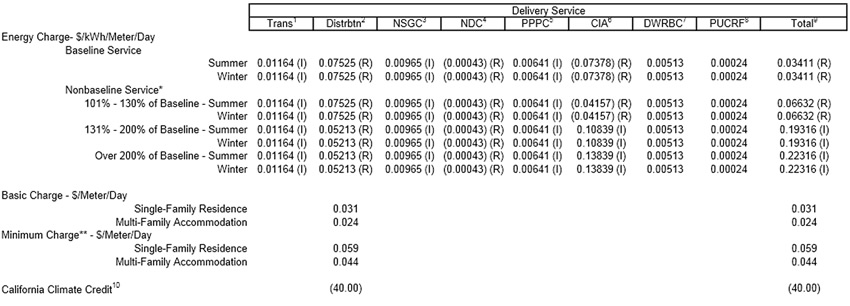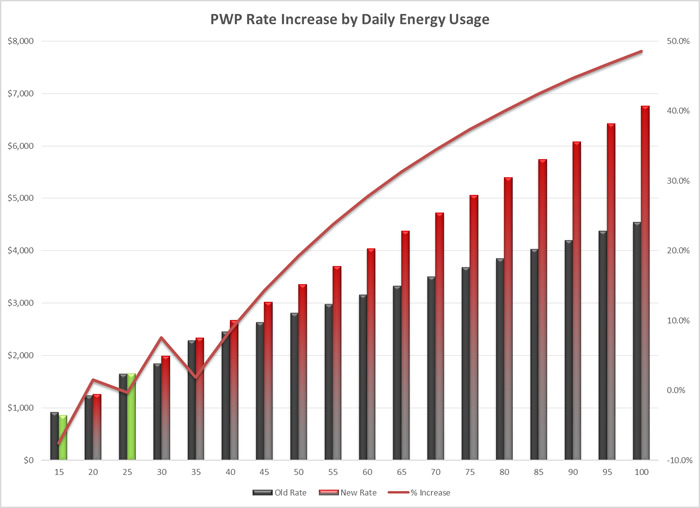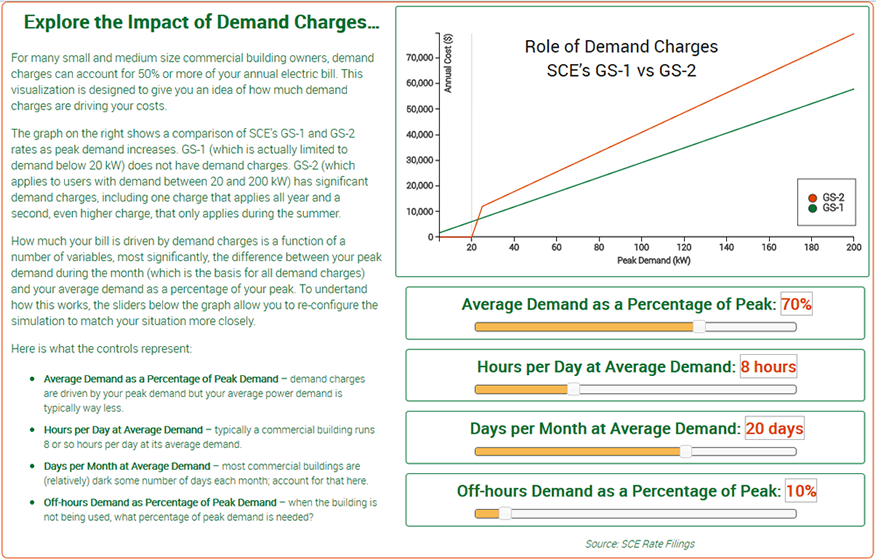Welcome to the
Run on Sun Monthly Newsletter

|
It seems that this is the season for double-digit rate increases, whether you are in SCE territory (your rates went up on June 1) or PWP (yours go up tomorrow!), we seem to be seeing a trend. So this issue lays it out in detail—but if you can't bear to look, feel free to just give us a call and we will help make the pain go away! In this issue: |
June, 2014
Volume: 5 Issue: 6
Just in time for Summer - SCE Jacks its RatesOne of our astute readers contacted us to ask if we had noticed that SCE had just increased their rates—and dramatically. That got our attention so we decided to spend some quality time amidst SCE's tariffs. The news is mixed: terrible news for people who are going to have to pay these crazy rates, but great news for everyone who can install solar. In fact, SCE's new domestic rate is about all anyone would need to be convinced to finally make the switch to solar. SCE's Tariff LibraryIn case you did not know it, every SCE tariff—that is, the rate structures under which they bill their customers such as the Domestic tariff for most residential customers or GS-1 and GS-2 for most commercial customers—can be found on their website. If you know where to look. (Hint: look here!) Of course, when you do find what you are looking for, you are rewarded with something that looks like this: This is one half of SCE's Domestic rate (the delivery portion)—and this is about the simplest rate structure that they use! So it is not surprising that most normal people don't really examine these things to see what is going on—they just groan and pay the bill. But we suspect people will do more than groan when they look at their bills this summer. Cruel, cruel SummerWe had been working on a solar proposal for a prospective client in SCE territory when we learned about the rate change. The client's usage was relatively high, averaging 55 kWh/day over the course of the year; high, but still far lower than some of our clients. Under the rate structure in effect prior to June 1, this client's annual bill worked out to $5,100 but after applying the new rates her annual total jumped to $5,750—an increase of a whopping 12.7%! We will pause a moment to let that sink in. What about that other potential client we wrote about, the one whose SCE bill already contained an incredibly misleading chart purporting to help her understand her bill. What impact will these new rates have for her? Under the rates in place before June 1, her total bill for the year was an already eye-popping $8,435—ouch! But under the new rates? Her new bill becomes $9,560—an increase of 13.4%! So what is actually going on here? Turns out that the rates on the high end, Tiers 3 and 4, are the culprits, increasing by 16.4% and 14.8% respectively. Live in Tier 4 this summer and you will be paying 34.8¢/kWh for the privilege! Silver LiningThere is a silver lining here and that is that adding solar pays off better than ever. If your solar power system gets you out of Tier 4 alone, you will save thousands of dollars a year. For our prospective client who averaged 55 kWh per day, her savings come to $4,171 in Year 1. Even without a rebate from SCE (which for now at least has gone the way of the Dodo), her payback is in Year 5! After 10 years, thanks to these new rates, she will have saved an additional $25,000! And by avoiding a lease (this client is planning on using HERO financing), those benefits all go to her! We have said it before and we will say it again: utility rates are only going up. While this example pertains to just SCE's residential customers, guess what? You commercial customers are about to see your rates go up as well (more on that below). And muni customers, now is not really the time to feel smug as your rates are going up too (and yes, PWP folks, we mean you!). Give us a call and let's see if we can't help—contrary to the song, we've got a cure for these summertime blues! |
“Live in Tier 4 this summer and you will be paying 34.8¢/kWh for the privilege!…”
Get your copy of
Commercial Solar:
Step-by-Step
from
Run on Sun
Founder & CEO
Jim Jenal

Now available on Amazon.com
in both
Print & Kindle versions.
Commercial Solar:
Step-by-Step
from Run on Sun
Founder & CEO
Jim Jenal

Now available on Amazon.com
in both Print & Kindle versions.
Help Us Spread the News!




Pasadena's Electric Rates Spark ConcernPasadena Water and Power (PWP) is set to roll out an entirely redesigned Residential rate structure that could spark serious concerns if you are a big user of energy. Here's our analysis. PWP customers have been pretty smug (something we are apparently famous for) as we sit back and watch our neighbors in SCE territory suffer through significant rate increases. Well, no more. Now you too, fellow PWP customers, are about to feel the bite of a double-digit rate increase. And here's the thing—the more you use, the bigger that rate increase will be! PWP has a somewhat hybrid rate structure, meaning that while the pure energy charges are the same no matter how much energy you use (in contrast with SCE's four-tier rate structure), other components, most notably the customer and distribution charges, are actually tiered. In the newly revised rate structure the customer charge is now split out and is a flat fee of $7.76/month. The distribution charge, however, remains tiered under the new structure, albeit in an odd fashion. The first 350 kWh of energy per month see a low distribution charge of just 1.5¢/kWh. The next 400 are really jacked up: to 11.65¢/kWh before subsiding to 8.5¢/kWh for every kWh thereafter. Which raises the question: if you want to incentivize people to reduce their usage, why is the third tier lower than the second? As a result of the change in structure as well as the rate components, the impact on your bill varies a lot depending on your usage, as you can see from the following chart:
As you can see, two bars (at 15 and 25 kWh) actually show rate decreases and the percentage increase continues to swing back and forth until you get to 35 kWh per day when the increase is monotonically upward. But wow, if you are sucking down 100 kWh/day, your rates will go up by nearly 50%! Fortunately, very few customers are in such rarefied air as that; but a homeowner who had an average usage of about 25 kWh/day who then goes out and purchases an EV that she drives a lot, could bump into the 50 kWh range and she would see a 19% rate increase. Have a big house with a pool and a jacuzzi and a couple of EVs? If that gets you to 80 kWh/day your rate increase will be 40%! In fact, it is actually worse than what we are showing here since this is only looking at the energy services part of your bill. On the left-hand-side of your bill you will find the Public Benefit Charge (tied to how much energy you use) and it is going up by 19%. On top of that are taxes that you pay on those energy services amounts and you can see that PWP customers, except on the lowest end of the scale, are in for some serious rate hikes starting July 1. Of course, solar is the perfect hedge against these rate increases (and others sure to come in the future) and PWP still is offering the highest rebates around: $0.85/Watt. But in all likelihood we will see those rebates step down soon so now is the time to act! Give us a call at 626-793-6025 and let's get started. |
SCE Spikes GS-1, GS-2 RatesSo that's the bad news for SCE and PWP residential customers, but what about commercial customers? Well for businesses operating under SCE's GS-1 and GS-2 rates, your bad news starts now. GS-1 and GS-2 ExplainedSCE's commercial customers (what it refers to as general service, hence the "GS") are largely divided into two groups: those that pay only for monthly energy usage (GS-1) and those that pay for both usage and peak power demand charges (GS-2). You can use all the energy you want in a month, but as long as your peak power demand never exceeds 20 kW you will stay in GS-1. Once your demand sneaks past 20 kW however, you will be consigned to paying higher bills under GS-2. Solar for GS-1 customers is a no brainer, just as it now is for SCE's residential customers. For GS-2 customers, however, the question is a tougher call since it can be very hard to know how well solar will coincide with a potential client's peak power demands, and it is those demand charges that so drive the pain of GS-2 bills. Neither GS-1 nor GS-2 are tiered, meaning that every kWh of energy is charged the same. Under GS-2, however, demand charges are significantly higher during the summer than they are the rest of the year. We have a cool simulator (based on the old rates) that shows how your actual usage drives the difference between GS-1 and GS-2 rates. To try this for yourself, click on the image above to go to the visualization page. GS-1We said that you could use all of the energy you like and remain in GS-1 but that's not strictly true—if your peak power demand stays below 20 kW you can only pull so much energy into your site. Let's imagine a commercial entity that is right under that limit: say 19 kW peak demand and they sustain that demand for 10 hours a day, every day. The remaining 14 hours their demand drops to just 5 kW. Their daily usage averages: Usage = 10*19 + 14*5 = 190 + 70 = 260 kWh/day. Under the old rate, this maxed-out GS-1 customer would have seen a bill of $15,355 or roughly 16.2¢/kWh. (A bargain, by the way, compared to what a residential customer using that much energy would have paid.) Under the new rate, their bill jumps to $16,777 an increase of 9.26%, and now they are paying 17.7¢/kWh. GS-2We recently provided a proposal to a potential GS-2 client, so we will model their usage to demonstrate what the new rates will do to a GS-2 customer's bill. Their usage has peak demands that average 119 kW per year, but spike as high as 167 kW during the summer. Their daily energy usage is substantial as well, ranging between 600 and nearly 1,000 kWh per day from winter to summer. Under the old rates, they were paying some $56,873 or 21.73¢/kWh. The new rates will see their bill climb to $59,598, and increase of 4.79%, averaging 22.77¢/kWh. But here's the interesting thing about the new GS-2 rate: it is actually more beneficial to solar customers, since the increase is mostly in the per kWh charge. Indeed, when we model our potential client's savings in Year 1 under the new rate as compared to the old, it increases by over $1,000—going from $14,808 to $15,818, a 6.8% savings increase for no additional out-of-pocket expense! Their payback now occurs in Year 6 instead of Year 7, their IRR increases from 12.2% to 12.9% and they will have saved an additional $12,000 in Year 10 than they would have under the old rates. (Combine the solar power system with intelligent storage and you are really on to something.) Bottom LineSCE's rates are going up for all classes of customers that we see: residential (12%+), small commercial (9%), and large commercial (4.8%). Solar can help all of these customer classes, and GS-2 customers can see an even greater savings from solar under the new rates than they could before. Oh, and SCE still has some rebate money for commercial projects, but that won't last for long. Stop suffering, start saving—make this the Summer you go solar. |



